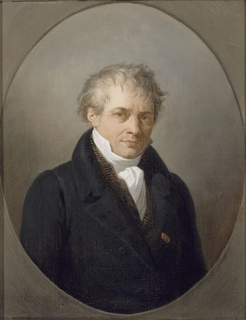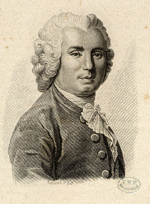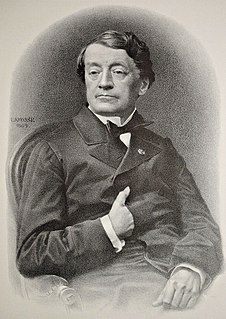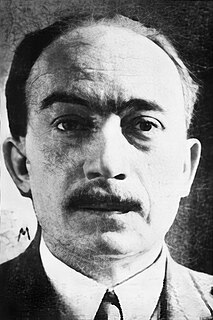
Typometry was a short-lived relief printing technique developed during the 18th and 19th centuries to compose maps, drawings and other designs, using moveable type to reproduce words, lineworks and map symbols. [1] [2] [3]

Typometry was a short-lived relief printing technique developed during the 18th and 19th centuries to compose maps, drawings and other designs, using moveable type to reproduce words, lineworks and map symbols. [1] [2] [3]
During the European Renaissance, many engravers and printers revolved to typography to solve the problem of small lettering on maps, which was very difficult to reproduce solely by using custom engraved lettering. One of the techniques they relied on was the setting of metal type, which was fitted inside a special form, surrounded by spacing material. Words set that way could then be overprinted over woodcut-printed maps as a separate plate, either in black or coloured ink. [1] This technique has been considered a precursor of the typometric technique of the 18th century. [4]
In the 18th century, the German deacon August Gottlieb Preuschen (1734–1803), from Karlsruhe, published two books on the art of printing maps using movable type. [5] The books were printed in Basel, Switzerland, using type from the foundry Haas'sche Schriftgiesserei , by Wilhelm Haas-Münch (1741–1800). Wilhelm Haas-Münch has been quoted as the inventor of typometry in 1776, [6] in competition with Johann Gottlob Breitkopf of Leipzig. [7] The name typometrie was proposed by August Gottlieb Preuschen himself, the former name of the method being ingénieurie d'estampes (sic.) (engraving's engineering, in French in the original). [3] [8]
After some rudimentary tests by Preuschen, the 1776 map of the Canton of Basel [9] (in cuarto format) was the first map created by this technique. [5] Some others would follow, such as the 1777 map of Sicily, [10] which features toponyms printed with moveable type as well as roads, coasts, divisions and rivers printed with folding metal filaments. Special moveable topographic symbols mark the mountain ranges of the island, its fortifications, and other landmarks.
The printer Johann Gottlob Immanuel Breitkopf, based in Leipzig (Germany) was at first critical with the invention, claiming that it was impossible to accurately adapt and assemble different shapes of types to create a new form. [11] But, after the typometric prints were proven to be successful, he began experimenting himself with the technique, [12] and he printed a map of the whereabouts of Leipzig by using it.

In the early 19th century, two different issues of a French review called the Bulletin de la Société d’Encouragement pour l’Industrie Nationale contains articles about typometry. The first one, of 1808, refers to the research work of Mr. Periaux and Mr. Poterat, to produce typometric maps, to generate a viable alternative to engraved maps. [13] The second article, of 1825, introduces the advancements made by Firmin Didot, son, in the technique of printing maps by using typographic means. [14]
The polychrome maps of France [15] made by Didot were sold at the price of 1 franc and 50 cents, which was more affordable than the monochrome engraved maps of the time. [16] Typometric maps, even with their inferior detail quality, were also considerably faster to produce than engraved maps. After Didot, and until 1832, printers Wegener the Young in Berlin [3] and Georg Michael Bauerkeller (1805–1886) in Frankfurt am Main [8] did some essays with the technique for producing maps, but without attaining much success.
It was not until 1839 in Vienna that the Austrian geographer Franz Raffelsperger (1793–1861), having prefected his own printing methods without knowing the work of his predecessors, produced a typometric postal card of the Austrian Empire of unprecedented quality. [3] This postal card was rewarded with the golden medal at the industrial exhibition that took place that year in Vienna, [3] and the next year he opened his own typometric press in that city. [2] Raffelsperger produced moveable type characters that allowed him to print every possible feature in a map, including geographic and topographic features, mathematical and geometric symbols, architectural landmarks and even plants and animals. He also designed custom symbols for cities, forests and other elements, that he printed in five different text sizes and in several languages. He then combined these this typometric technique with polychromy, so he could print moveable type characters for each geographical feature of the map with their very own precise colour hue. The different available sizes of his printing components allowed him to print his maps in several sizes without losing quality, and that at a very reduced cost. [3]
After Raffelsperger, other European printers continued to experiment with typometry, and several examples were presented at the 1855 International Exhibition in Paris. [3] [17] However, with the advent of lithography, invented by Alois Senefelder in 1796, typometry was confronted with another method that was even better at reproducing detail and that allowed to print several solid colours at a low price, so it was progressively abandoned. [12]
On comprend sous le nom collectif et générique de typomètre l'art de composer et imprimer, au moyen de types mobiles, les cartes géographiques, les dessins mathématiques et géométriques, ceux des plans des machines, d'objets d'histoire naturelle, et même des portraits. [English: We understand typometry, collectively and generically, as the art of composing and printing, by means of mobile type, geographical maps, mathematical and geometrical drawings, plans for machines, natural history objects, and even portraits.]
Il inventa en 1772 une presse à bras où les jumelles de bois étaient remplacées par des pièces métalliques et en 1776 l'impression cartographique en caractères mobiles.
Der Name "Typometrie" stammt von dem Diakon Preuschen, der feine Methode zuerst "Ingenieurie d'Estampes" getauft hatte.

Antoine César Becquerel was a French scientist and a pioneer in the study of electric and luminescent phenomena.
Didot is the name of a family of French printers, punch-cutters and publishers. Through its achievements and advancements in printing, publishing and typography, the family has lent its name to typographic measurements developed by François-Ambroise Didot and the Didot typeface developed by Firmin Didot. The Didot company of France was ultimately incorporated into the modern CPI printing group.
Deberny & Peignot was a French type foundry, created by the 1923 merger of G. Peignot & Fils and Deberny & Cie. It was bought by the Haas Type Foundry (Switzerland) in 1972, which in turn was merged into D. Stempel AG in 1985, then into Linotype GmbH in 1989, and is now part of Monotype Corporation.

Firmin Didot was a French printer, engraver, and type founder.

Honoré Théodore Paul Joseph d'Albert, 8th Duke of Luynes, inheritor of several French titles as duc de Luynes, de Chevreuse et de Chaulnes and an immense fortune, who cut a figure of grand seigneur and supported the exiled comte de Chambord's claim to the throne of France, is remembered most for the collection he gave to the Cabinet des Médailles in 1862.

Jean Paul Louis François Édouard Leuge-Dulaurier was a French Orientalist, Armenian studies scholar and Egyptologist.
Jacques Chéreau was a portrait engraver, printmaker and publisher of optical prints in a neighborhood of printmakers at the Rue Saint-Jacques variously given on prints as "au Grand St. Remy," "au Coq," or "au dessus de la Fontaine St. Severin", in Paris, France.

Antoine-Jacques Roustan was a Genevan pastor and theologian, who engaged in an extensive correspondence with Jean-Jacques Rousseau. Unlike Rousseau, he believed that a Christian republic was practical - that the Christian religion was not incompatible with patriotism or republicanism.

Théophile de Bordeu was a French physician.
Alexandre Chaponnier called Polyanthe was a 19th-century French physician, painter, engraver, and playwright.
Antoine-François Ève, also known by the name Ève Demaillot and the pseudonyms Antoine-François Ève-Démaillot, Démaillot, Ève Démaillot, Desmaillot, Maillot, Des Maillots..., was an 18th-century French comedian, man of letters, journalist and revolutionary.

Théodore-Éloi Lebreton was a 19th-century autodidact French poet, chansonnier and bibliographer.

Léon, Marquis de Laborde (1807–1869) was a French archaeologist and traveler.
Jean Castaing was an 18th-century French poet, playwright and printer.
François Le Prévost d'Exmes was an 18th-century French writer, playwright and literary critic.

A typometer is a ruler which is usually divided in typographic points or ciceros on one of its sides and in centimeters or millimeters on the other, which was traditionally used in the graphic arts to inspect the measures of typographic materials. The most developed typometers could also measure the type size of a particular typeface, the leading of a text, the width of paragraph rules and other features of a printed text. This way, designers could study and reproduce the layout of a document.

Émile Mireaux was a French economist, journalist, politician and literary historian. In the 1930s he edited Le Temps and contributed to other right-leaning journals. He became a senator in 1936, and briefly served as a minister in 1940. From 1940 until his death he held a chair in political economy, statistics and finance at the Académie des Sciences Morales et Politiques.

Paul de Rousiers was a French social economist and industrial lobbyist. He was a follower of Pierre Guillaume Frédéric le Play, and believed in industrial syndicates that would be independent of both workers and owners, and would be dedicated to the progress of their industries. He undertook studies of society and economic organization in the United States, Britain and Germany, where he visited the rural areas, towns, cities, farms, mines and factories, and spoke to workers, owners, politicians and intellectuals to gain an understanding of the interplay of social and economic forces. His work gained him considerable respect.
François Louis Julien Simon Héron was a French revolutionary, an agent of the Committee of General Security.
Léon-Jean-Joseph Dubois (1780-1846) was a French illustrator and lithographer, also an archaeologist and curator at the Louvre museum.